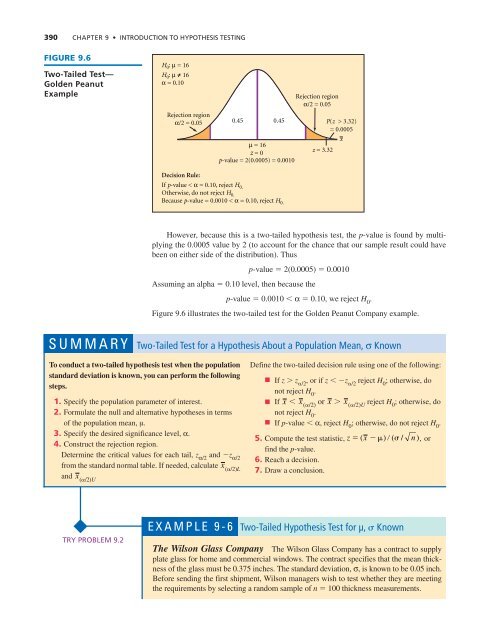Chapter 9: Introduction to Hypothesis Testing
Chapter 9: Introduction to Hypothesis Testing
Chapter 9: Introduction to Hypothesis Testing
Create successful ePaper yourself
Turn your PDF publications into a flip-book with our unique Google optimized e-Paper software.
390 CHAPTER 9 • INTRODUCTION TO HYPOTHESIS TESTING<br />
FIGURE 9.6<br />
Two-Tailed Test—<br />
Golden Peanut<br />
Example<br />
H 0 : μ = 16<br />
H 0 : μ = 16<br />
α = 0.10<br />
Rejection region<br />
α/2 = 0.05<br />
Decision Rule:<br />
0.45<br />
0.45<br />
μ = 16<br />
z = 0<br />
p-value = 2(0.0005) = 0.0010<br />
Rejection region<br />
α/2 = 0.05<br />
z = 3.32<br />
P(z > 3.32)<br />
= 0.0005<br />
x<br />
If p-value < α = 0.10, reject H 0.<br />
Otherwise, do not reject H 0.<br />
Because p-value = 0.0010 < α = 0.10, reject H 0.<br />
However, because this is a two-tailed hypothesis test, the p-value is found by multiplying<br />
the 0.0005 value by 2 (<strong>to</strong> account for the chance that our sample result could have<br />
been on either side of the distribution). Thus<br />
p-value 2(0.0005) 0.0010<br />
Assuming an alpha 0.10 level, then because the<br />
p-value 0.0010 α 0.10, we reject H 0<br />
.<br />
Figure 9.6 illustrates the two-tailed test for the Golden Peanut Company example.<br />
SUMMARY Two-Tailed Test for a <strong>Hypothesis</strong> About a Population Mean, σ Known<br />
To conduct a two-tailed hypothesis test when the population<br />
standard deviation is known, you can perform the following<br />
steps.<br />
1. Specify the population parameter of interest.<br />
2. Formulate the null and alternative hypotheses in terms<br />
of the population mean, μ.<br />
3. Specify the desired significance level, α.<br />
4. Construct the rejection region.<br />
Determine the critical values for each tail, z α/2<br />
and z α/2<br />
from the standard normal table. If needed, calculate x(/2)L<br />
and x(/2)U<br />
Define the two-tailed decision rule using one of the following:<br />
If z z /2<br />
, or if z z /2<br />
reject H 0<br />
; otherwise, do<br />
not reject H 0<br />
.<br />
If x x (/2)<br />
or x x (/2)U reject H 0<br />
; otherwise, do<br />
not reject H 0<br />
.<br />
If p-value α, reject H 0<br />
; otherwise, do not reject H 0<br />
.<br />
5. Compute the test statistic, z( x ) ( / n)<br />
, or<br />
find the p-value.<br />
6. Reach a decision.<br />
7. Draw a conclusion.<br />
TRY PROBLEM 9.2<br />
EXAMPLE 9-6 Two-Tailed <strong>Hypothesis</strong> Test for µ, Known<br />
The Wilson Glass Company The Wilson Glass Company has a contract <strong>to</strong> supply<br />
plate glass for home and commercial windows. The contract specifies that the mean thickness<br />
of the glass must be 0.375 inches. The standard deviation, σ, is known <strong>to</strong> be 0.05 inch.<br />
Before sending the first shipment, Wilson managers wish <strong>to</strong> test whether they are meeting<br />
the requirements by selecting a random sample of n 100 thickness measurements.

















